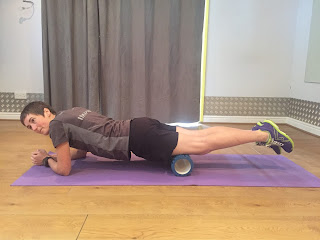Whilst it’s almost always more fun to have someone else massage your sore bits it’s also expensive and time consuming. That’s why lots of runners are familiar with the strange pleasures and pains of auto-malaxation, or foam rolling as its more commonly know.
Whether gyrating on a tennis ball to release your glute, suspending yourself above the lounge floor on a foam roller whilst watching Mock the Week or driving to work perched on Rover’s Ruffer and Tuffer spikey dog ball, we all feel the need to help it all hang loose from time to time.
Many of you will already be close friends with these torture tools and will use them on a regular basis whilst others may feel more than a little curious as to what exactly they are and what they can and can’t do for you.
So what are they?
Put simply, we’re talking about any implement or tools that allows you to do deep massage to your own fascia and muscle, with foam rollers being perhaps the most well known.
Why might you want to use them?
As an alternative to stretching to restore ‘normal’ flexibility, mobility and range to muscles and fascia (myofascia), or to increase flexibility in chronically tight myofascia.
If you haven’t already you may be interested to read my previous blog on the benefits or otherwise of stretching.
Does it work?
Yes, of course. Probably.
Foam rolling is an even more divisive topic than stretching. Many physiotherapists, coaches and athletes swear by them and use them in an almost ritualistic manner. Others find very little benefit and some find they can aggravate pain and tightness in their tissues.
What does the science say?
The general consensus from available research into foam rolling is that it improves flexibility i.e. range of movement.
It can also reduce soreness after a workout. Whether this is a good thing or not is another question - some see this soreness as part of the adaptation process and by easing it you may be reducing the effectiveness of this adaptation process and hence of training. However if you have another race the next day then reducing soreness could be beneficial.
How does it work?
When asked most people you will probably describe how it breaks down scar tissue, knots, adhesions or lactic acid.
But does this really happen? No.
To ‘break down’ tissue in the way described above you would need to apply significantly higher forces than a human is able to exert on themselves.
So what are we actually doing when we roll on foam?
"it is thought that the pressure applied by the foam rolling reduces the localised myofascial tightness by stimulating the fascial mechanoreceptors to signal the central nervous system to alter the activity of the muscle(s) below." (Science for sport)
This is one hypothesis, there are other similar or more complex ideas. The short answer is we know it increases flexibility but we don’t really know how it does it.
Does it hurt?
It’s not necessary for it to hurt to be helping. Applying pressure to the point of mild discomfort results in the same increases in flexibility as more painful rolling.
The more it hurts the greater the risk of you aggravating your symptoms. In particular if your system is already sensitised to pain due to an injury then subjecting it to further significant pain is unlikely to aid recovery.
Try to adjust the pressure so that you get the sensation you want - it should feel like it’s doing something but not too painful.
Which muscles should I target?
- The one’s that feel tight.
- The one’s that feel tired and used - if you’ve just run a race with lots of downhills then target the quads, if you’ve been doing lots of fast running on hard surfaces or jumping exercises then try the calves.
- The one’s above and below an injured site - if you have a sore hip then target the lower back, glutes, quads and hamstrings. Hopefully this may loosen of the surrounding area allowing the injured area to move as it should.
How much and how often?
Research suggests two to three sets of thirty to sixty seconds rolling per muscle repeated three to five times per week - although if I’ve learned anything in my career as a physiotherapists it’s that individuals are individual.
Can you do harm?
Yes.
Trying to foam roller or use a massage ball on tendons can cause further irritation of the tendon.
I’ve seen patients hardly able to walk after too much foam rolling on already aggravated tendons.
It’s also possible for the pain system to perceive the massage as a threat i.e. something that might damage the tissue. In some cases this can cause muscles to tighten further to protect the area causing more tension and discomfort not less.
So, would you recommend I do it?
If you have a clear reason or aim for trying it then yes.
You may want to improve mobility through tight glutes, loosen off sore spots in your lower back or massage tight calves.
If it's achieving what you want then continue to use it. If you don’t feel it’s helping you then try other methods or see a physiotherapist who can work with you to establish why something is tight or sore and how to address it.
In particular, if you feel foam rolling is making you worse i.e. tighter or sorer, then stop. It’s not helping!

